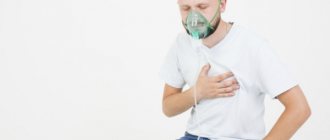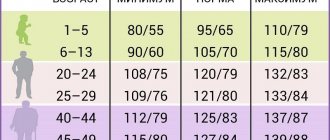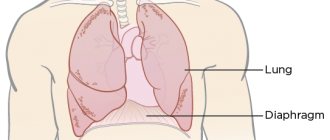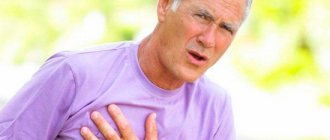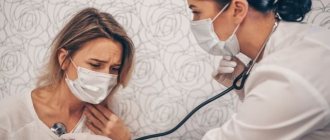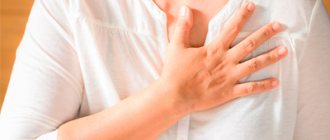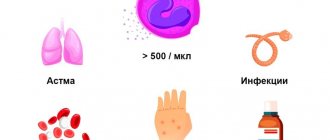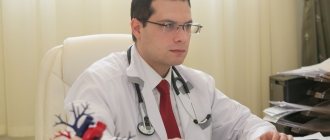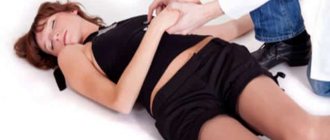A condition in which the rhythm, frequency and depth of breathing is disrupted, and a feeling of air deficiency occurs, is called shortness of breath. The causes and treatment of this disorder can be very diverse. Shortness of breath can occur under various conditions. So, for example, there is shortness of breath when talking, shortness of breath when lying down, after sleep, shortness of breath at rest, etc. The breathing of a person with shortness of breath is frequent and noisy; it is these manifestations that give others reason to assume the presence of shortness of breath. Shortness of breath can be a consequence of quite serious diseases, therefore, when it appears, it is necessary to contact a specialist as quickly as possible, who will competently explain what shortness of breath is and how it manifests itself, and also prescribe a comprehensive diagnostic examination to identify the causes of its occurrence.
The Therapy Center of the Yusupov Hospital offers high-quality diagnostics and effective treatment of diseases accompanied by shortness of breath. If necessary, a pulmonologist can be called to your home.
Types of shortness of breath
Shortness of breath can be of several types:
- inspiratory (shortness of breath while inhaling), expiratory (during exhalation) and mixed (with difficulty in inhaling and exhaling);
- tachypnea (increased shallow breathing) and bradypnea (decreased breathing);
- physiological - transient, reversible intensification of breathing (shortness of breath during physical exertion). The causes of shortness of breath in this case are that it is an adequate adaptive response to stress, injury, or an objectively low level of oxygen in the inhaled air;
- pathological (in case of airway obstructions due to bad habits, cardiovascular failure, obesity, lung diseases, hematopoietic system, etc.).
Risk factor
Paroxysmal nocturnal shortness of breath may occur if you are at increased risk of developing heart or lung disease. Risk factors for developing heart failure include:
heart disease
- high blood pressure
- cardiac ischemia
- high cholesterol
- diabetes
- obesity
- tobacco and alcohol use
- low activity level
- unhealthy diet
Risk factors for developing lung diseases:
- tobacco smoke
- air pollutants
- allergens
Why does shortness of breath occur?
If a person suddenly develops severe shortness of breath, the reasons can be very diverse. Most often it is caused by the following conditions:
- cardiovascular diseases – due to these pathologies, blood circulation is impaired. Internal organs suffer from a lack of oxygen, and carbon dioxide accumulates in the blood. The body’s reaction to this condition is increased breathing: a larger volume of air is pumped through the lungs per unit of time. In the supine position and after physical activity, shortness of breath associated with heart pathology occurs or intensifies. Severe shortness of breath occurs with the patient sitting or half-sitting. This kind of shortness of breath is characterized by difficulty breathing;
- diseases of the respiratory system - the appearance of shortness of breath is associated with obstacles to the passage of air through the respiratory tract (for example, narrowing of the lumen of the bronchi). Therefore, shortness of breath is considered a typical symptom of bronchial asthma. With this disease, the patient experiences difficulty in exhaling. In addition, shortness of breath occurs in cases where the respiratory surface of the lung tissue is reduced. Such a decrease is accompanied by an increase in the intensity of lung function, i.e. frequent inhalation, which is necessary to maintain the required amount of oxygen entering the blood. The list of pathologies of the respiratory system accompanied by shortness of breath includes neoplasms, pneumonia, chronic obstructive pulmonary disease, etc.;
- anemia - even with normal activity of the lungs and heart, a deficiency of hemoglobin and red blood cells leads to insufficient provision of the organs with the necessary amount of oxygen. To compensate for this disorder, the body increases its breathing rate;
- neuroses and panic attacks - in these cases, clinical examinations do not reveal the presence of cardiovascular and pulmonary pathologies, but subjectively the patient suffers from lack of air, and the appearance of psycho-emotional changes provokes increased breathing, which causes shortness of breath;
- various tumors – shortness of breath occurs with a tumor of the thalamus, intestinal tumors, etc.;
- problems with the gastrointestinal tract. For example, hoarseness, cough, shortness of breath with esophagitis are characteristic symptoms;
- obesity and diabetes are common causes of shortness of breath.
Causes of shortness of breath – respiratory system disorders
The causes of shortness of breath can be both heart disease and changes in the hematopoietic system. But the examination begins with studying the condition of the respiratory system. First of all, these are the lungs and bronchi. It is important to make sure that the lung tissue is not damaged, that one of the lungs does not contain malignant tumors, and whether the lungs have been subjected to a toxic attack, which can be either chemical poisoning or long-term tobacco smoking.
The development of pneumonia is another factor that provokes shortness of breath. It does not matter what etiology the pneumonia is. It can be either viral or bacterial. And both diseases cause the development of swelling of the lung tissue, as a result of which the organ cannot perform its functions. Many patients with a high percentage of lung damage from pneumonia are forced to be on a ventilator.
The bronchi play an important role in the process of delivering oxygen to the lungs. Each bronchus has a mucous membrane that can react acutely to external stimuli. For example, with bronchial asthma, the inner surface of the bronchi greatly increases in size, blocking the lumen of the tubular organ. It is impossible to take a full breath in such a situation. Another serious condition is bronchospasm, which also makes breathing very difficult. The result is shortness of breath.
Shortness of breath in people of different age categories
Shortness of breath can occur in people of all ages, from infants to the elderly.
In children, shortness of breath can be both physiological and pathological. The appearance of physiological shortness of breath is caused by physical exertion or high anxiety, which is considered normal. When the respiratory system is immature, pathological shortness of breath occurs in the infant. How to determine the type of shortness of breath and its causes is decided by the pediatrician, selecting the necessary diagnostic methods.
In old age, people's tolerance to physical activity decreases and the efficiency of the respiratory system decreases. Due to age-related changes, the physical strength of the respiratory muscles decreases, as a result of which gas exchange worsens and normal breathing becomes difficult. In addition, older people tend to have diseases of the cardiovascular system and lungs, which lead to shortness of breath. Most often, they do not pay attention to this symptom for a long time, so the diseases that accompany it are diagnosed at advanced stages. As a result, treatment becomes more difficult, the quality of life and its duration are significantly reduced. So it is better to immediately seek medical help if shortness of breath occurs in older people, without waiting for the condition to worsen.
The best pulmonologists in Moscow - Doctor of Medical Sciences, Professor Alexander Vyacheslavovich Averyanov, Candidate of Medical Sciences Alexander Evgenievich Shuganov are receiving appointments at the therapy center of the Yusupov Hospital. Klina is equipped with innovative high-tech equipment for conducting the most modern diagnostic studies. Thanks to an integrated approach involving specialized specialists in various fields, our doctors identify the exact cause of shortness of breath and select an effective treatment regimen, taking into account the individual characteristics of each patient.
Paroxysmal nocturnal dyspnea or orthopnea
PNO and orthopnea cause breathing problems when a person lies down. However, there are some key differences.
PNO causes difficulty breathing during sleep, causing people to wake up short of breath. A 2011 article notes that this condition often occurs 1-2 hours after a person falls asleep. However, symptoms improve when the person wakes up and sits up.
In orthopnea, shortness of breath occurs when a person lies down.
Unlike PNO, symptoms of orthopnea can occur while a person is awake. Similar to PNO, symptoms may improve when a person sits or stands. Orthopnea is caused by congestion in the lungs when a person lies down. This may be the result of blood redistribution when the body is in a horizontal position. In people with orthopnea, the heart's left ventricle cannot pump out additional blood. This increases the pressure in the pulmonary veins, causing fluid to enter the lungs, leading to shortness of breath.
What is shortness of breath in humans: symptoms
The occurrence of shortness of breath in the initial stages of damage to the cardiovascular and respiratory systems is associated with physical exertion (for example, when the patient climbs up the stairs). As the pathology progresses, shortness of breath and fatigue appear even with a slight load (walking on a flat surface, tying shoelaces, etc.), as well as at rest.
Patients perceive shortness of breath quite subjectively. It may be accompanied by the following symptoms:
- difficulty breathing (inhalation/exhalation);
- compression in the chest;
- feeling of congestion in the chest area;
- tightness in the chest;
- feeling of lack of air;
- inability to take a deep breath or exhale completely;
- suffocation.
How to get rid of shortness of breath after coronavirus: drugs and procedures
If there is severe shortness of breath after coronavirus and pneumonia, treatment should be prescribed and its effectiveness monitored by a pulmonologist or therapist. The following medications may be prescribed.
- Bronchodilators. Necessary for those who, due to coronavirus, have increased hyperreactivity of the respiratory tract to various irritants, allergens, and asthmatic manifestations.
- Mucolytics. Needed for accumulation of viscous, poorly discharged mucus in the lower respiratory tract. They help to liquefy it, which makes it easier to remove sputum.
- Secretomotor means. Stimulate expectoration at the reflex level.
- Immunomodulators . They will be useful to all those who have recovered from Covid, since resistance to the new coronavirus literally exhausts the immune system, which slows down recovery.
- Antibiotics. May be necessary in case of bacterial infection of lungs weakened by Covid.
In case of shortness of breath due to cardiovascular or psychosomatic disorders, specialists should also prescribe appropriate medications.
However, it should be taken into account that an excessive drug load on an organism weakened by the virus and previous drug therapy is extremely undesirable. The summation of the side effects of potent drugs can be much more dangerous than the same shortness of breath or residual cough.
Physiotherapy and the use of vitamin complexes and natural dietary supplements are the answer to the question of how to treat shortness of breath after coronavirus without medications. Among the procedures for respiratory disorders that will be useful:
- inhalations with mineral and sea water, essential oils, herbal compositions; the use of drugs in the form of inhalations will reduce the load on the kidneys, liver and other organs, compared to taking them orally;
- hyperbaric oxygenation – saturation of the patient’s body with oxygen in a pressure chamber; this method is especially useful for those who experience hypoxia due to poor breathing;
- UHF - the effect of an electromagnetic field on the chest area in the area where the lungs are located, improves the patency of small bronchi;
- massage to activate blood circulation and metabolism, eliminate congestion in the lungs and bronchi, which often results in shortness of breath after coronavirus;
- electrophoresis with medicinal solutions (calcium chloride, potassium iodine, aminophylline) to dilute sputum and remove it from the respiratory tract, relieve inflammation.
- SMT is the action of alternating current on a problem area of the body to stimulate recovery processes.
Shortness of breath: diagnosis
Diagnosis of the underlying pathology that provoked shortness of breath is carried out using the following research methods:
- general examination (general medical examination, counting the frequency of respiratory movements of the chest, listening to the lungs with a phonendoscope);
- general blood test;
- chest radiography;
- computed tomography of the chest;
- spirometry (spirography) – to assess air flow through the respiratory tract and the ability of the lungs to expand;
- tests using a bronchodilator - spirometry is performed before and after inhalation with a bronchodilator drug. This study allows us to evaluate the reversibility of bronchial narrowing;
- bronchoprovocation test - spirometry is performed before and after inhalation of histamine and methacholine. It is carried out to detect increased sensitivity of the bronchi, which causes bronchospasms;
- studies of the gas composition of the blood (the level of tension in the blood of carbon dioxide, oxygen is determined, the saturation of the blood with oxygen is assessed);
- body plethysmography – allows you to evaluate the function of external respiration. It is used to assess all volumes and capacities of the lungs, incl. those that spirography cannot determine;
- electrocardiography (ECG), echocardiography (ultrasound of the heart, echocardiography) - allows you to assess the functional state of the heart and pressure in the pulmonary artery system;
- fiberoptic bronchoscopy is a study that is used to examine the mucous membrane of the bronchi from the inside and study its cellular composition with a special preparation. The use of this method is advisable for patients with an unclear diagnosis. Allows you to exclude other possible diseases with similar symptoms;
- angiopulmonography – during the procedure the blood vessels of the lungs are examined;
- lung biopsy;
- consultations with a pulmonologist, cardiologist.
Severe shortness of breath after coronavirus: what to do?
Difficulty breathing after coronavirus is not a reason to panic. However, this symptom cannot be ignored. It is important to monitor its dynamics (the above mMRC scale and pulse oximeter will help with this).
If shortness of breath is severe, symptoms increase, or there are no changes for the better within several weeks, you need to look for the cause. Specialists such as a therapist, pulmonologist, cardiologist and neuropsychiatrist will help with this. The latter should be contacted if psychogenic shortness of breath occurs after coronavirus and therapy for neurosis, depression, and panic attacks is required.
A number of recommendations will help speed up the rehabilitation of respiratory function.
- Do breathing exercises daily. Doctors advise starting them during illness and continuing for at least a month after recovery. In addition to eastern practices, the methods of Strelnikova and others, vocal exercises, inflating balloons and exhaling air through a thin tube into the water have a good effect. It is also worth paying attention to whether you are breathing correctly in principle. The technique of proper breathing stimulates recovery processes not only in the lungs, but throughout the entire body.
- Moderate sports activity after covid . Physical activity improves blood and lymph flow, preventing stagnation. However, overload after illness is dangerous. It’s better to start with light daily exercise for about twenty minutes. Increase the number and severity of exercises gradually. For more serious training, it is advisable to obtain permission from a cardiologist. Light cardio exercise and swimming are the most beneficial for your health.
- Quitting cigarettes. Smoking greatly inhibits the regeneration of tissues of the respiratory system, and the toxins contained in tobacco smoke increase inflammation by activating allergic reactions.
- Walks in the fresh air and frequent ventilation of the apartment. You also need to maintain optimal air humidity in the house - 30–60%.
- Elimination of harmful environmental factors. It is worth spending less time on polluted main streets. At home, do not forget about wet cleaning - the most effective way to combat dust. If there are industrial impurities in the air at work or general weakness does not allow you to return to your usual work, it makes sense to take a vacation.
- Balanced and vitamin-enriched nutrition. Replacing smoked meats, marinades, fast food, trans fats and sweets with vegetables, fruits, herbs and berries will speed up recovery.
Shortness of breath: treatment
Pulmonologists at the Yusupov Hospital Therapy Center select an individual drug therapy regimen for each patient, depending on the disease that provoked the onset of shortness of breath.
The clinic’s rehabilitators draw up a plan for physical training and pulmonary rehabilitation to increase the patient’s tolerance to physical activity, and prescribe breathing exercises using various methods (diaphragmatic breathing, inflating balloons, blowing air through a tube, etc.) that train the respiratory muscles.
In severe cases, artificial ventilation is used.
Shortness of breath accompanies pathologies of various organs and systems of the human body. Therefore, each individual case requires specific therapy, aimed primarily at eliminating the underlying disease causing shortness of breath.
How to treat shortness of breath caused by cardiovascular diseases?
Patients with shortness of breath associated with cardiovascular diseases are prescribed therapy, the goals of which are:
- improve oxygen supply to the heart;
- increase cardiac output;
- reduce blood stagnation in the lungs.
The use of nitrates, glycosides, and diuretics is effective. Patients with heart failure are recommended to always have nitroglycerin available, which helps to immediately dilate the blood vessels of the heart muscle.
Oxygen therapy is used to replenish the lack of oxygen in the blood.
How to get rid of shortness of breath: first aid
Providing first aid for shortness of breath to a person suffering from heart disease involves doing the following:
- call an ambulance;
- before the arrival of doctors, it is necessary to ensure the flow of fresh air into the room where the patient is located by opening the window;
- the patient must be seated on a chair;
- remove the tie and scarf from the patient’s neck, unbutton the top buttons on the shirt;
- Place a nitrosorbide tablet under the patient’s tongue and give any diuretic.
How to cure shortness of breath associated with pulmonary diseases?
For shortness of breath caused by pulmonary pathologies, patients are advised to drink plenty of alkaline fluids (except for patients with pulmonary edema).
To relieve bronchospasm, selective β2-adrenergic agonists (salbutamol, fenoterol, terbutaline, formoterol, clenbuterol, salmeterol) are prescribed. M-cholinergic receptor blockers are effective for relaxing the muscles of the bronchi.
Patients suffering from bronchial asthma are prescribed inhalations with NSAIDs and steroid therapy.
Treatment of shortness of breath due to bronchitis involves the use of medications to separate sputum. These include:
- acetylcysteine;
- carbocysteine;
- bromhexine;
- ambroxol.
How to get rid of shortness of breath associated with allergies?
Every person suffering from allergic diseases should know what to take for shortness of breath of this etiology:
- diazolin;
- diphenhydramine;
- suprastin;
- tavegil;
- fenistil;
- claritin;
- desloratodine, etc.
As an additional therapy for shortness of breath caused by allergies, you can use traditional medicine: decoctions of plants that have an expectorant effect (from plantain, pine buds, coltsfoot), as well as hot foot baths.
How to deal with shortness of breath of a psychogenic nature?
Shortness of breath quite often accompanies mental disorders - melancholy, panic attack, depression. Patients suffering from these conditions are prescribed sedatives, antidepressants and tranquilizers. The use of therapeutic hypnosis is also effective. Treatment is prescribed exclusively by a psychotherapist.
Shortness of breath, especially at rest, is an alarming symptom that often manifests quite serious pathologies that require immediate examination and urgent medical care. Therefore, if such a respiratory disorder occurs, it is necessary to urgently visit your doctor. You can make an appointment with a therapist or pulmonologist at the Yusupov Hospital by calling the phone number listed on the clinic’s website.
How to check respiratory function after coronavirus?
There is a breath test that doctors recommend doing if you suspect impaired lung function. It consists of three simple steps:
- You need to inhale air through your nose. The inhalation should be as long and deep as possible.
- Time your stopwatch for 10 seconds and do not exhale during this time.
- After 10 seconds, begin to exhale as long as possible through your mouth.
You should consult a doctor (generalist or pulmonologist) if during testing:
- there was a feeling of discomfort in the chest;
- there was a cough;
- my throat was very sore.
Also, prolonged shortness of breath after coronavirus is a reason to purchase a pulse oximeter. This device for measuring oxygen levels in the blood will help you watch for critical, life-threatening deterioration in respiratory function.
3. Symptoms and diagnosis
Shortness of breath at rest - i.e. in a relaxed state, outside of physical activity, during sleep or rest - can manifest itself in different ways and be accompanied by various additional symptoms, which is determined by the root cause of respiratory disorders.
Thus, cardiovascular dyspnea is accompanied by tachycardia, cyanosis, coldness and swelling of the extremities; patients complain of the inability to “take a deep breath” and frequent attacks of “night suffocation.” Against the background of such attacks, whether at night or during the day, life-threatening conditions often develop.
Pulmonary dyspnea is characterized by chest pain, weakness, drowsiness, low-grade fever, cough, and asthmatic-type breathing difficulties. However, these, as well as many other symptoms, appear in various combinations, since they depend on specific causes and diseases (infectious, obstructive, oncological, and many others).
Central neurogenic dyspnea usually manifests itself as sharply rapid shallow breathing, “linked” to a specific type of stressful situations.
Hormonally caused shortness of breath is often caused by the release of adrenaline during intense experiences of fear, anxiety, and excitement.
Diagnosis and qualification of resting dyspnea requires auscultation and percussion examination of the chest, external examination, careful study of complaints and anamnesis, laboratory blood tests (clinical, biochemical, hormonal, gas composition analysis, etc.), radiographic or tomographic examination. Depending on the suspected causes, spirometric (respiratory) and cardiological tests (ECG, EchoCG, treadmill test, bicycle ergometry, Holter monitoring, etc.), consultation and examination with a neuropsychiatrist, endocrinologist, nephrologist and other specialists are prescribed.
About our clinic Chistye Prudy metro station Medintercom page!
Which doctor should I contact if I have shortness of breath?
If this clinical manifestation is regular, you should first visit your doctor. He will conduct an examination, collect anamnesis - and, based on the information received, send the patient to an appointment with a specialist in pulmonology, cariology, hematology, neurology or endocrinology.
If a patient has a traumatic injury to the chest, he should consult a traumatologist. In cases where shortness of breath is part of an emergency condition - it appears suddenly and sharply - you should immediately call an ambulance.
